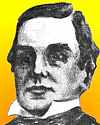 (source)
(source)
|
Samuel Morey
(23 Oct 1762 - 17 Apr 1843)
American inventor who patented a steam-powered boat years before Robert Fulton, and held the first patent for an internal combustion engine.
|
AMERICAN WATER BURNER.
from The American Monthly Magazine and Critical Review (1819)
An apparatus called the American Water Burner has been invented by Mr. Morey, of New-Hampshire, who, after making many experiments, and employing various combustible substances, as tar, rosin, oil, &c. to mix with the steam, has brought his apparatus to perfection. The construction is very simple: Tar is intimately mixed with steam or vapour of water, and made to issue, with a force proportional to the pressure of the steam, from a small orifice, like that in the jet of a blow-pipe, and is there fired. The flame, although the combustible substances issue from so small an orifice, is as large as that of a common smith’s forge, and is accompanied with smoke: when this flame is directed against the bricks in the back of a tire-place, they soon become heated to redness: if iron or steel filings be thrown into the flame, they burn with a sparkling brilliancy, similar to iron wire in oxygen gas.
A few experiments have been made to ascertain the effect of steam on burning bodies, and to learn whether it probably suffered decomposition when issuing, mixed with tar, from the jet of the water-burner.
If a jet of steam, issuing from a small aperture, be thrown upon burning coal, its brightness is increased, if it be held at a distance of four or five inches from the pipe through which the steam passes; but if it be held nearer, the coal is extinguished, a circular black spot first appearing where the steam is thrown upon it. The steam does not appear to be decomposed in this experiment: the increased brightness of the coal is probably occasioned by a current of atmospheric air produced by the steam.
If the wick of a common oil lamp be raised so as to give off large columns of smoke, and a jet of steam be thrown into the flame, its brightness is a little increased, and no smoke is thrown off.
If spirits of turpentine be made to burn on a wick, the light produced is dull and reddish, and a large quantity of thick smoke is given off; but, if a jet of steam be thrown into the flame, its brightness is much increased; and if the experiment be carefully conducted, the smoke entirely disappears.
If vapour of spirits of turpentine be made to issue from a small orifice, and inflamed, it burns, giving off large quantities of smoke; but if a jet of steam be made to unite with the vapour, the smoke entirely disappears.
The same effect takes place if the vapour of spirits of turpentine and of water be made to issue together from the same orifice: hence the disappearing of the smoke cannot be supposed to depend on a current of atmospheric air.
If the flame of a spirit-lamp be brought in contact with a jet of steam, it disappears, and is extinguished at the points of contact, precisely as when exposed to strong blasts of air.
Masses of iron of various sizes, and heated to various degrees from redness to bright whiteness, were exposed to a jet of steam; no flame appeared, as was expected, but the iron was more rapidly oxidated where the steam came in contact with it than in other parts. It is probable, if the water suffered decomposition in this experiment, and if the hydrogen was inflamed, its flame might not be observed when contrasted with the heated iron, a body so much more luminous.
The operation of the water-burner, then, appears to be simply this: Tar, minutely divided, and intimately mixed with steam, is inflamed; the heat of the flame, aided by the affinity for oxygen of that portion of carbon which would otherwise pass off in smoke, decompose the water, and the carbon and oxygen unite ; the hydrogen of the water, and probably of the tar, expand on all sides (and hence the flame is very large) to meet the atmospheric oxygen; water is recomposed, and passes off in steam; a degree of heat is produced, no doubt, greater than that which is produced by the combustion of the tar alone; and this heat is equal to that evolved by the combustion of a quantity of carbon which would otherwise form smoke.
The invention is ingenious, and may be found very useful in steam-boat navigation, where it has already been applied. Probably a saving of heat would he produced by condensing the products of this combustion, which might effected to a certain degree by an apparatus of simple construction.
- 23 Oct - short biography, births, deaths and events on date of Morey's birth.




